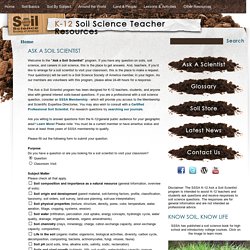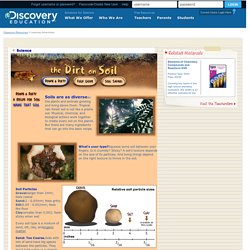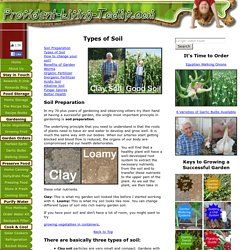

Ask a Scientist. Welcome to the “Ask a Soil Scientist” program.

If you have any question on soils, soil science, and careers in soil science, this is the place to get answers. And, teachers, if you’d like to arrange for a soil scientist to visit your classroom, this is the place to make a request. Your question(s) will be sent to a Soil Science Society of America member, in your region. As our members are volunteers with this program, please allow 24-48 hours for a response. Are you willing to answer questions from the K-12/general public audience for your geographic area? Please fill out the following form to submit your question. Dig Deeper. The Dirt on Soil - Learning Adventures. What's your type?

Squeeze some soil between your fingers. Is it crumbly? Sticky? A soil's texture depends on the size of its particles. And living things depend on the right texture to thrive in the soil. Soil Particles Gravel:larger than 2mm; feels coarse Sand:2 - 0.05mm; feels gritty Silt:0.05 - 0.002mm; feels like flour Clay:smaller than 0.002; feels sticky when wet Sand: Too Coarse.Soils with lots of sand have big spaces between the particles. Silt: Too Light.This is material which is finer than sand, but still feels gritty. Clay: Too Fine.Lots of clay makes the soil heavy and dense. The Science Of Soil. Scoop on Soil. Garden - How To Information.
Garden How to Make a Log Planter Shayna Orrino Contributed this How to Make a Homemade Flea and Tick Repellent Jessica Kielman Which Houseplants Are Best for Cleaning the Air?

How to Make a Homemade Mosaic Bird Bath Jonathan Fong 7 Tips to Keep Your Lawn From Turning Brown Debbie Williams How to Get Your Garden Ready for Summer How to Design a Backyard Patio How to Build Raised Garden Beds With Corrugated Metal How to Build an Outdoor Privacy Screen 12 Outdoor Games You're Going to Want to Play All Summer Long 9 Insanely Easy Hacks Every Gardener Should Know How to Build and Grow a Salad Garden On Your Balcony Sarah Dorsey Get your weekly DIY fix with our customized newsletter.
Thanks! Good stuff is on its way! How to Make a Vertical Clay Pot Garden Backyard BBQ: 5 Ways to Keep Your Guests Happy and the Bugs Out How to Keep Bugs Out of Your Pantry and Kitchen Table-less Spring Entertaining: 10 Essentials for a Backyard Picnic With Friends. 5 Soil Types. Last time, we discussed basic soil facts that you need to know before you started digging around in your garden.

This time, we’re going to look at different soil types and how to determine the kind of soil that’ll be host to your plants. There are 5 different soil types that gardeners and growers usually work with. All five is a combination of just three types of weathered rock particles that make up the soil: sand, silt, and clay. How these three particles are combined defines your soil’s type—how it feels to the touch, how it holds water, and how it’s managed, among other things. 1. Sandy soil has the largest particles among the different soil types.
Water drains rapidly, straight through to places where the roots, particularly those of seedlings, cannot reach. The upside to sandy soil is that it’s light to work with and warms much more quickly in the spring. 2. Silty soil has much smaller particles than sandy soil so it’s smooth to the touch. 3. 4. 5. Soil Health Awareness. Soil Health New: Soil Health Television PSAs TV ads highlight hope in healthy soil Recently, NRCS distributed a series of 15- and 30-second public service ads to 1,000 local television stations, the networks, the National Association of Broadcasters, and every state broadcast association in the country to highlight the critical role healthy soil plays in our lives, on our planet and in our future.

Click here. Types of Soil - Clay, Sandy, Silt, Acidic, Alkaline. Soil PreparationTypes of SoilHow to change your soil?

Benefits of Garden Worms Organic Fertilizer Inorganic Fertilizer Acidic SoilAlkaline SoilFungal SporesBetter Health Soil Preparation In my 70 plus years of gardening and observing others try their hand at having a successful garden, the single most important principle in gardening is soil preparation. The underlying principle that you need to understand is that the roots of plants need to have air and water to develop and grow well.
It is much the same way with our bodies. You will find that a healthy plant will have a well-developed root system to extract the necessary nutrients from the soil and to transfer these nutrients to the upper part of the plant. Clay: This is what my garden soil looked like before I started working with it. If you have poor soil and don't have a lot of room, you might want to try.